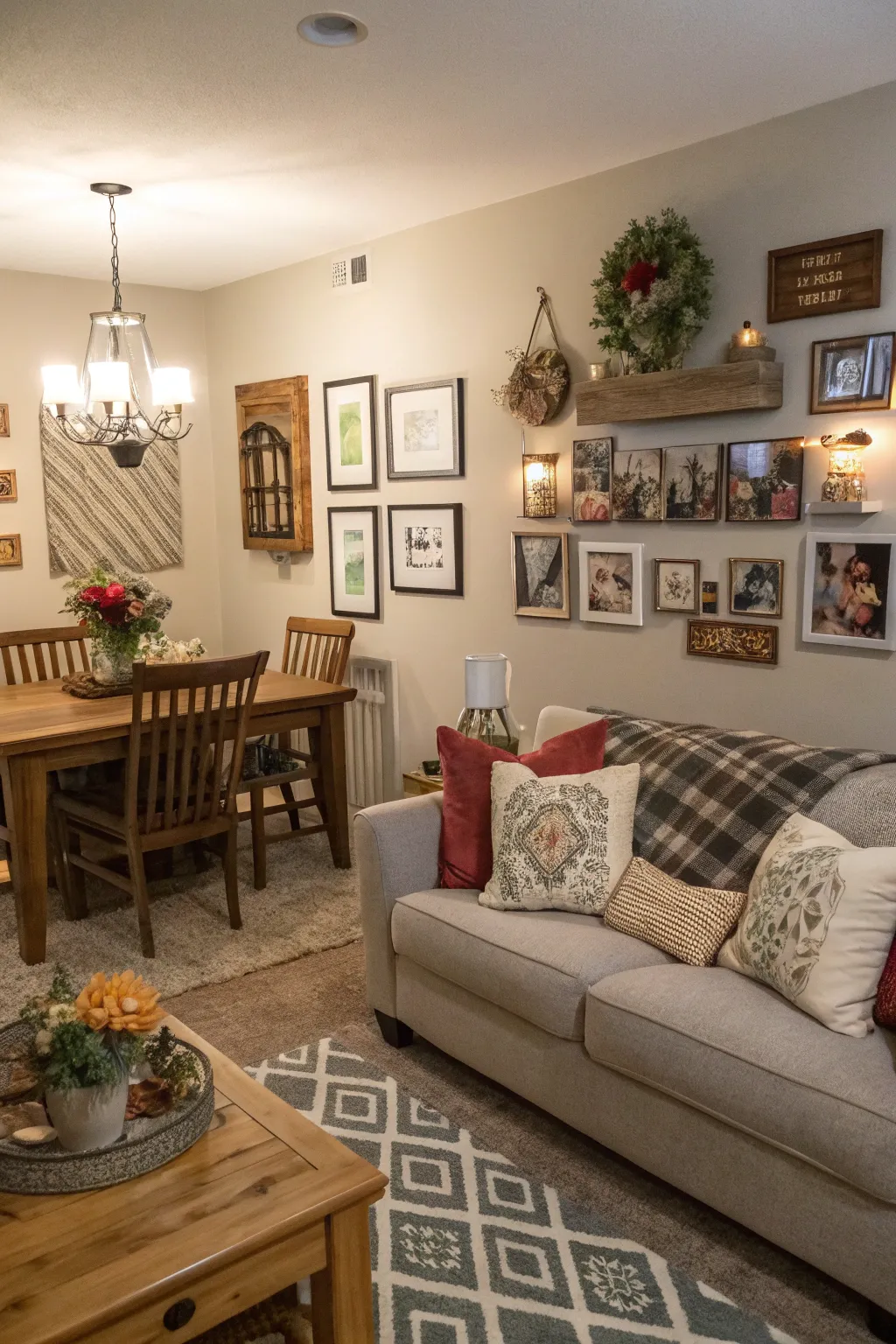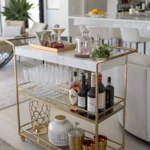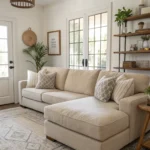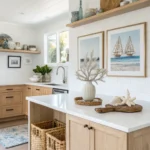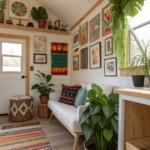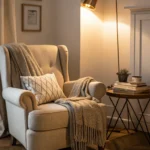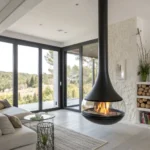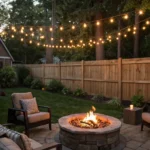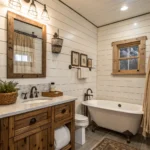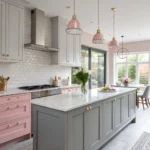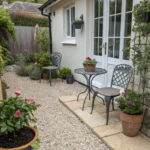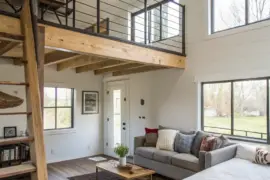Ever wondered how to make your living and dining rooms feel like one beautiful, functional space?
Let’s jump into some inspiring ideas that’ll bring your combo room dreams to life.
1. Let Mirrors Work Their Magic!
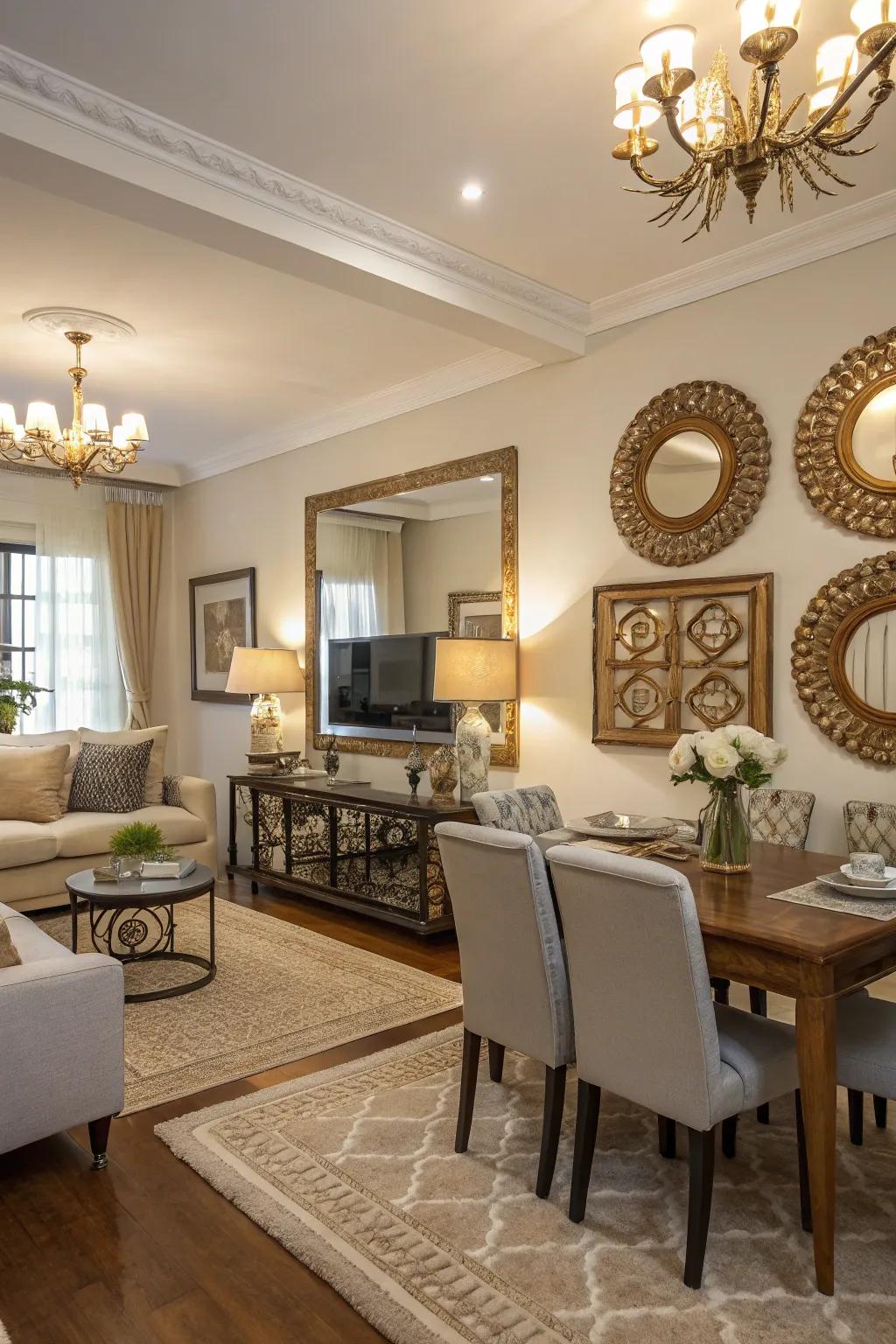
Mirrors are like design wizards. They bounce light, visually double the expanse of a room, and—when chosen thoughtfully—bring a sculptural, almost artful quality to your space. It’s no exaggeration to say: a well-placed mirror can be a game-changer, especially in those living room-dining room combos where every inch matters.
One of my favorite projects was with Linda and James—a couple downsizing into a more urban space. Their main worry? Feeling boxed in. We selected an oversized, vintage-inspired mirror for the wall facing their dining table and flanked it with smaller, round mirrors in the living area. Instantly, their home felt airier, brighter, and so much more inviting. There’s a reason why “reflecting your style” is more than just a pun—it can absolutely transform the atmosphere.
Want to maximize the benefits of mirrors? Here are my go-to tricks:
- Hang a large mirror opposite your main window to boost natural light.
- Cluster smaller decorative mirrors to craft an eclectic focal point over a sideboard or sofa.
- Try a mirrored console table in the dining area for subtle glamour.
- Use tall, narrow mirrors to visually heighten the ceilings.
How will you let mirrors work their magic for you? Sometimes, it only takes a single statement piece to give your combo room an open, breezy feel—or a playful collection to add personality. Don’t be afraid to experiment with shapes, frames, and placement. And remember—mirrors aren’t just for seeing your reflection; they’re for reflecting the energy you want in your home.
You might like:
2. Rugs: The Quiet Zoning Genius
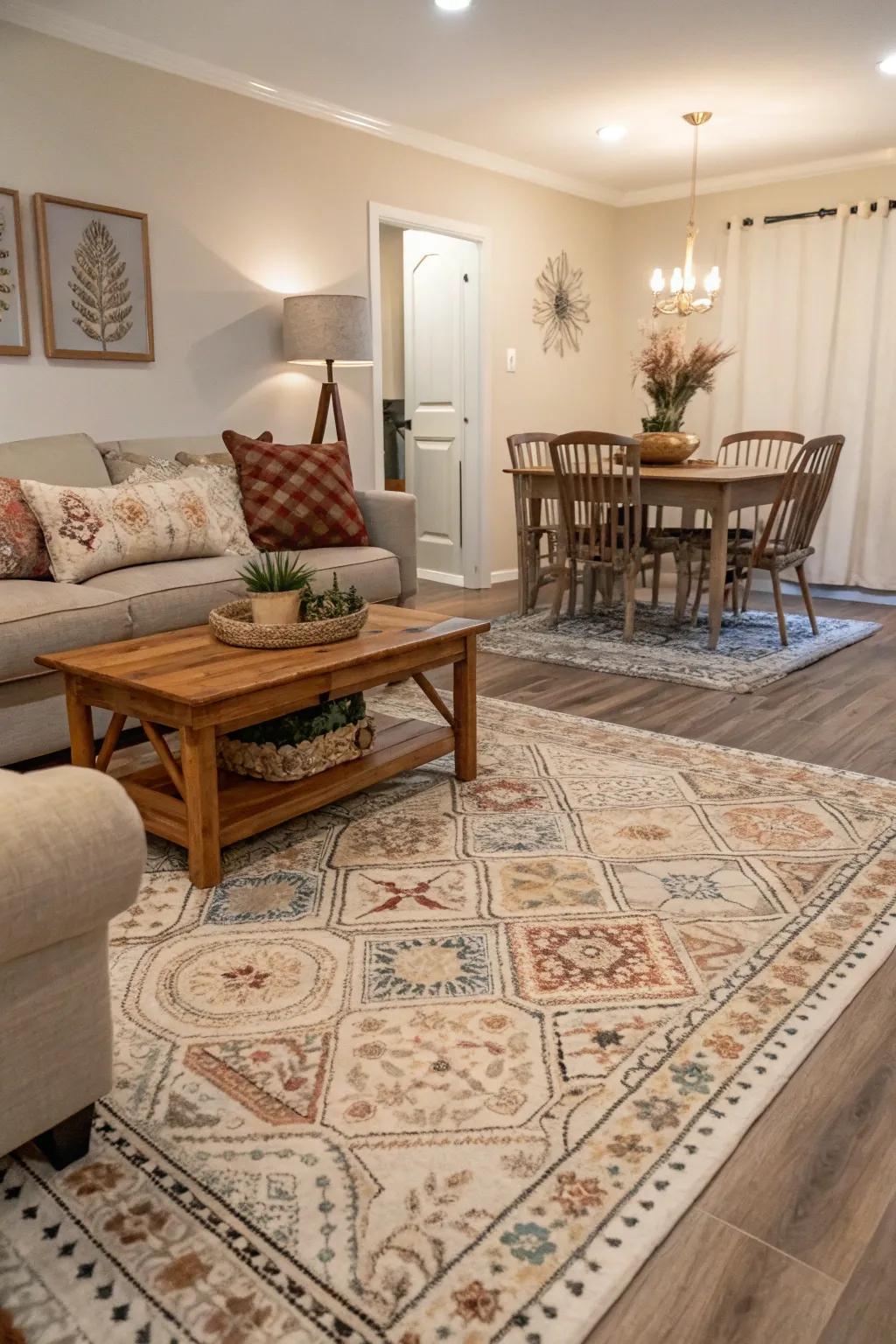
It’s amazing what a well-chosen rug can do for a combo space. If you want your living and dining areas to feel distinct yet connected, the answer might be right under your feet.
Start with a design you love—and don’t be afraid to go bold! Would you choose matching patterns, or contrast each area for more personality?
A few choices to try:
3. The Glow of Togetherness

Warm, low lighting has a secret power: it can draw people closer and set the scene for unforgettable evenings. I often suggest to my clients that they layer lighting rather than rely on a single overhead source. Once, I helped Michael and Lila transform their blended living-dining area into a softly-lit retreat using a mix of dimmable lamps and twinkling string lights. The change was instant—their room felt instantly more intimate, perfect for everything from quiet dinners to heartfelt chats.
Give yourself permission to play with shadows and highlights. With dimmers and soft-glow bulbs, you can shape the mood to fit any occasion—gentle for a deep conversation, or a little brighter for lively gatherings. Remember, light isn’t just functional; it’s emotional.
Give these a look:
4. Go Bold! Let Patterns Do the Talking and Energize Your Space
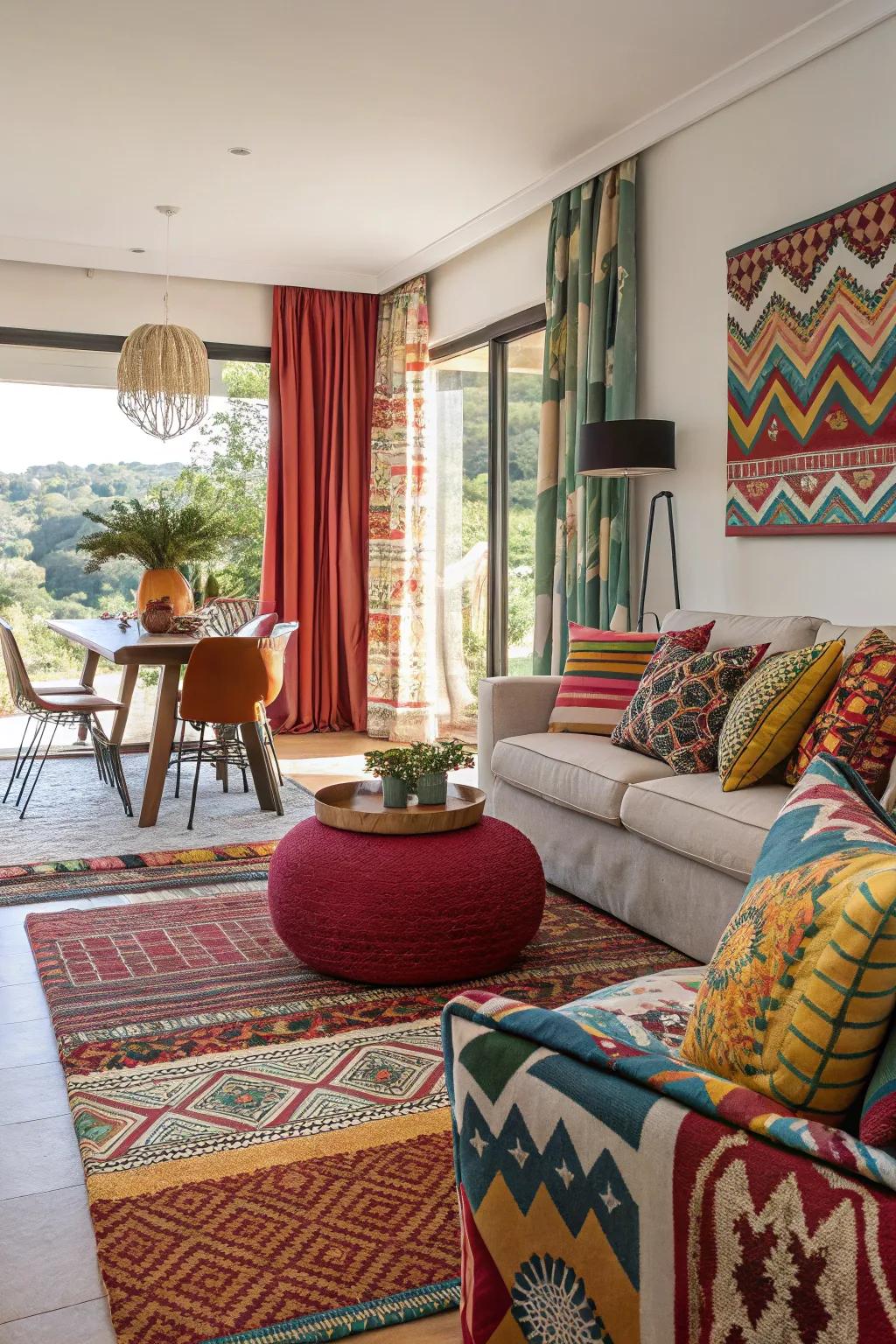
Ready to break free from bland? Bold patterns are like joyful exclamations for your home—they tell your story out loud.
When I worked with Javier, a young artist excited to bring life into his compact apartment, we played with patterns in unexpected places. Instead of sticking to safe neutrals, we chose a geometric rug as the anchor and mixed in vibrant, patterned cushions. The transformation was electric. The space didn’t just look lively—it felt alive, ready for creativity and laughter. If you’re hesitant, start with one big statement piece, then build fearlessly, using smaller accents for balance.
Want to try it yourself? Here’s how to mix patterns with purpose:
- Keep color palettes consistent to avoid visual chaos.
- Pair a bold element (like a rug) with subtler accents in similar tones.
Patterns aren’t just for the daring—they’re for anyone who’s tired of playing it safe. Like the old saying, “Variety is the spice of life”—it’s certainly true in home décor! If something makes you smile, let it shine. There’s nothing more inviting than a room that celebrates its owner’s personality.
These products might be useful:
5. Try Layering Textures—It’s Easier Than You Think
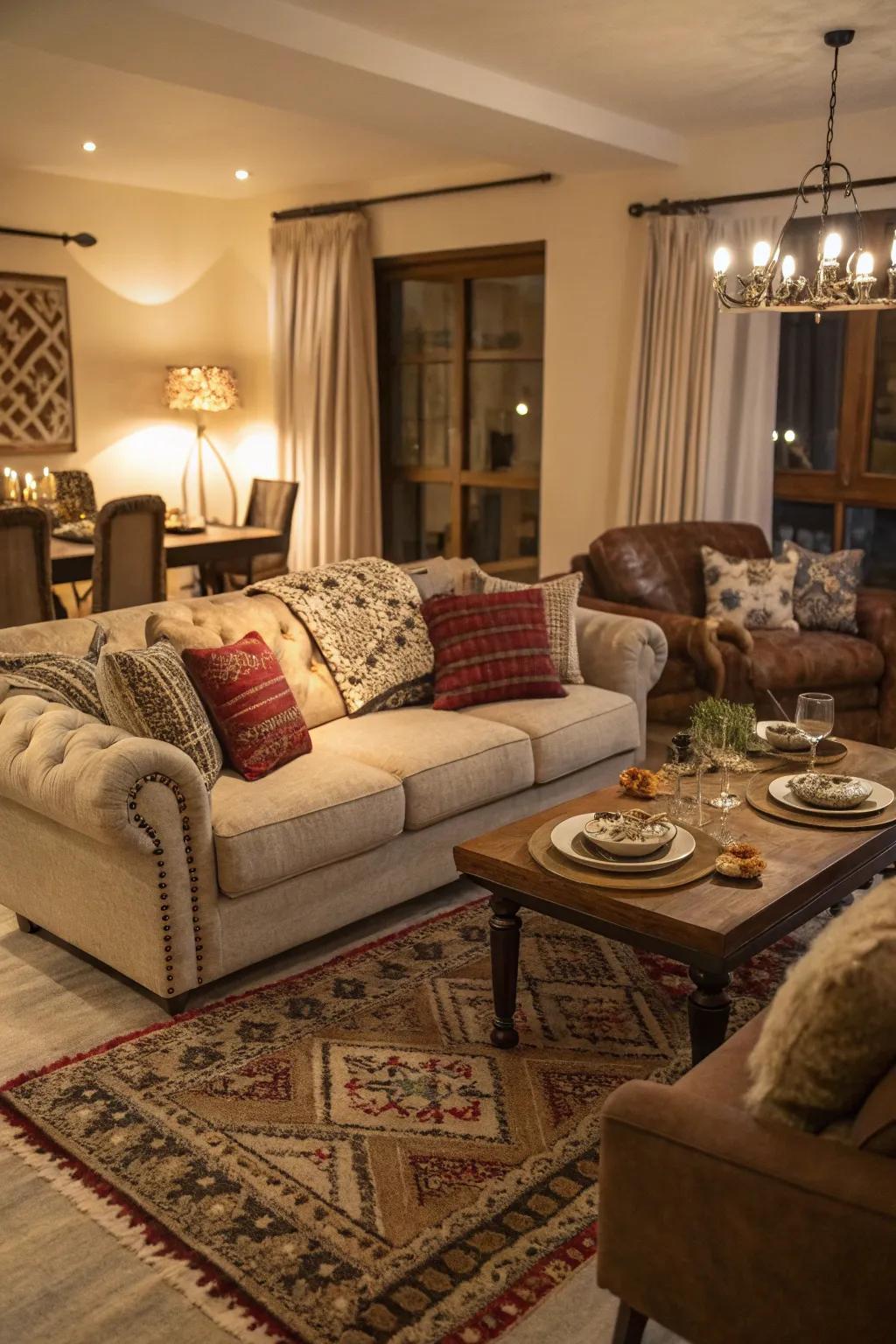
Imagine sinking your toes into a plush rug while soft linen cushions cradle your back and a woven throw invites you to linger. Layering texture is about creating comfort you can see and feel. Don’t stop at textiles—think about baskets, ceramics, or even an artfully distressed wood tray.
Texture is warmth, and home is all about warmth.
Check these products out:
6. Can Lighting Do More Than Illuminate? Absolutely!
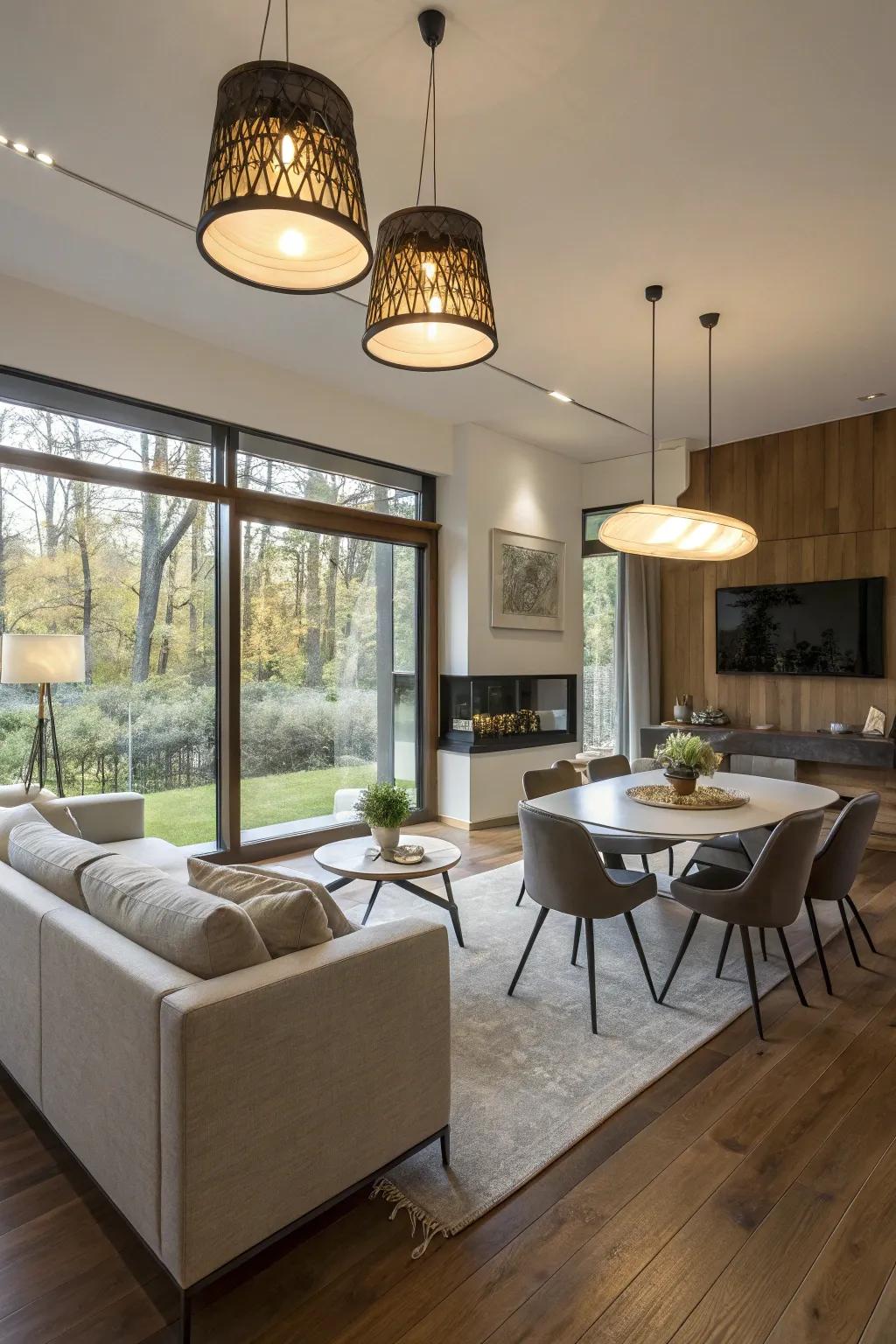
Lighting is the unsung hero of open concept spaces. The right fixtures can separate your dining zone from your lounging nook without ever raising a wall.
Let me let you in on a secret: pendant lighting above the dining table becomes a visual “full stop” (designers call it a focal point), while layered lamps introduce instant coziness to a sofa corner, perfect for winding down with a book or glass of wine.
- Pendant lights to define your eating spot
- Soft floor lamps to accent your living area
Try mixing materials—glass, metal, woven cords—for added personality.
Products that could assist:
7. Style Remix
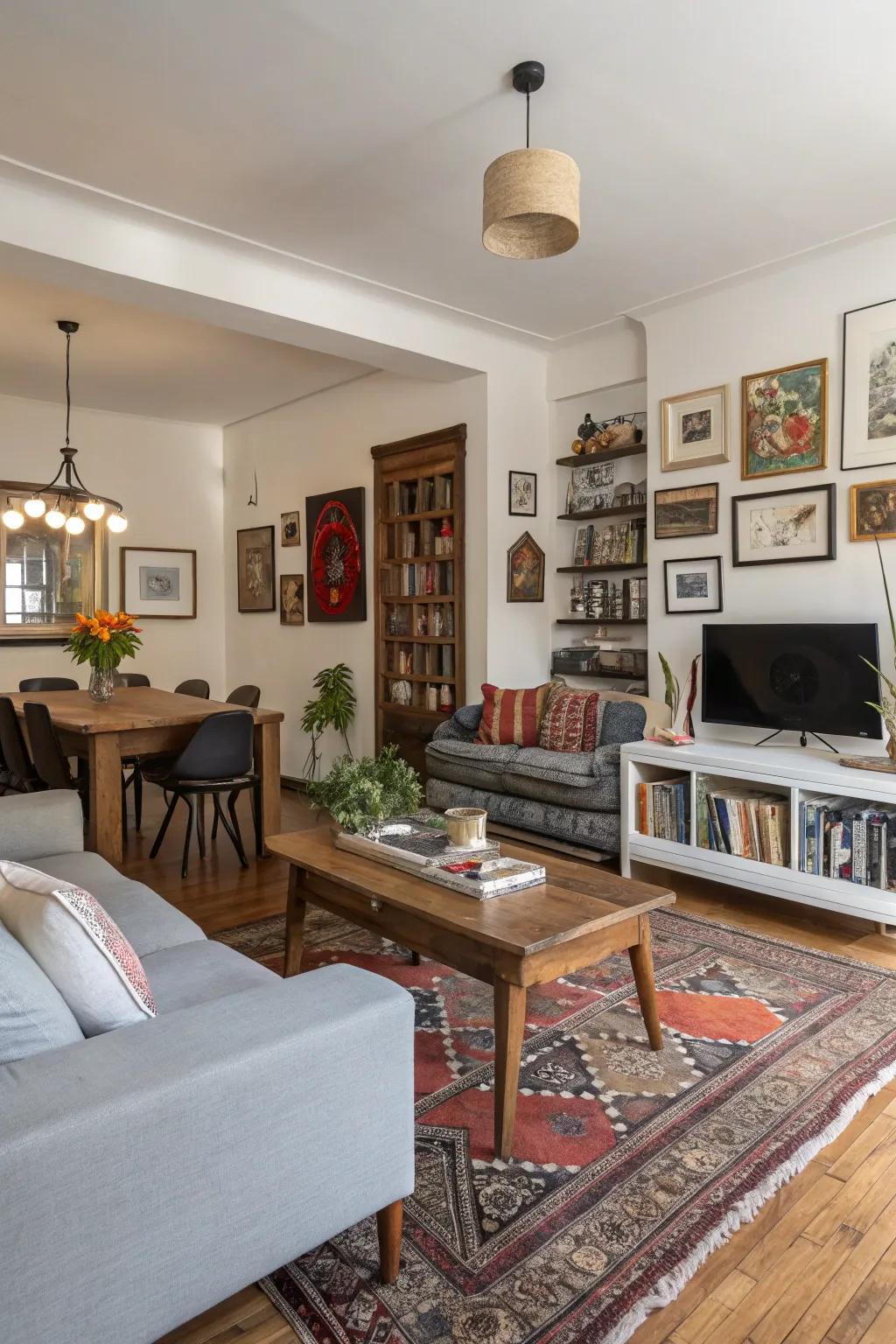
Sometimes, the magic happens when you blend the unexpected. Think of pairing a sleek, modern sofa with a cherished antique sideboard or a bold, contemporary light fixture over a classic farmhouse table.
This mix keeps your eye moving and your home’s story rich.
Go ahead—introduce something vintage amid your modern pieces, or anchor clean lines with heritage charm.
The best spaces, after all, tell your story, not just one era’s..
Consider these options:
8. Transform Your Living-Dining Combo with One Smart Furniture Swap—Try Multifunctional Pieces!
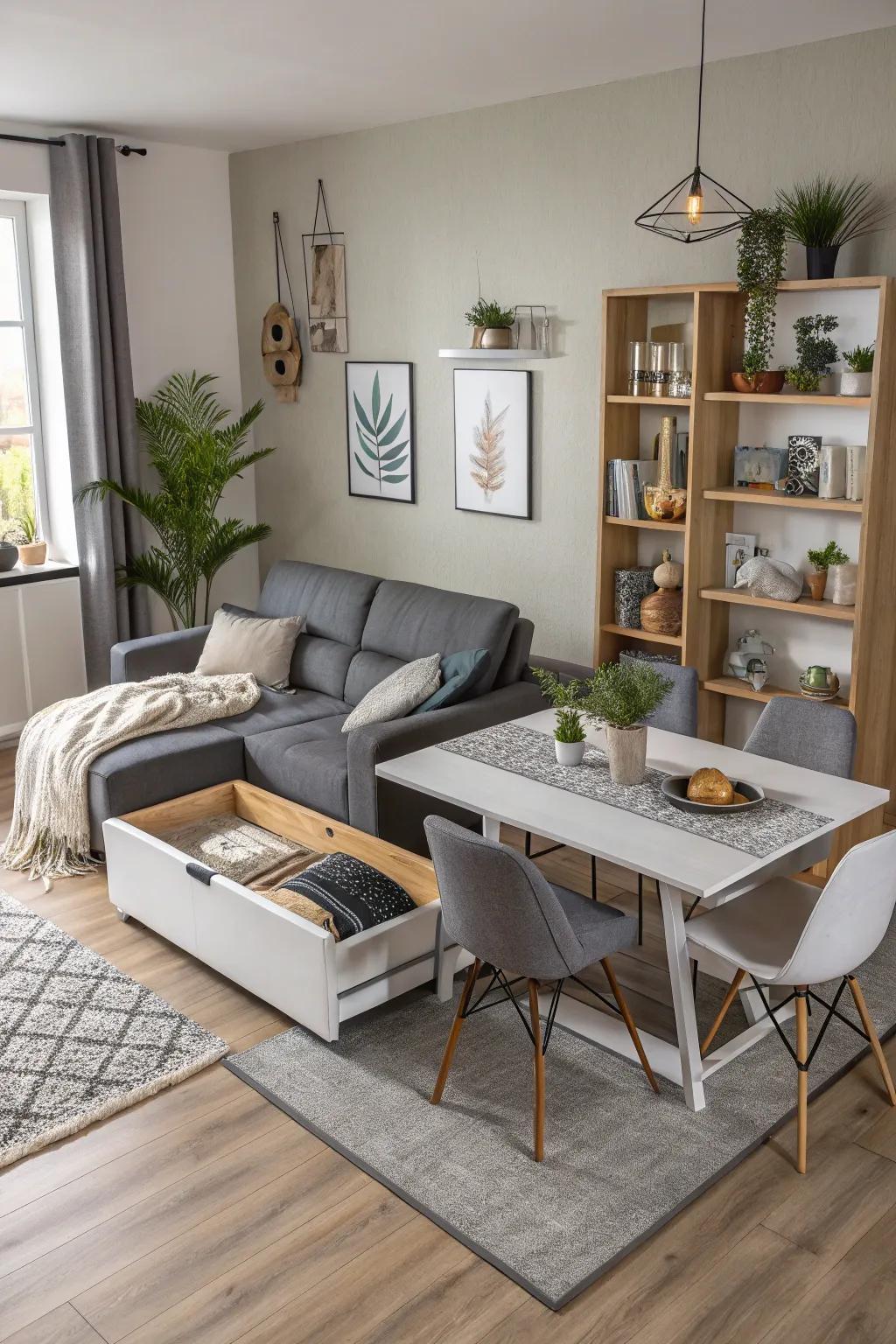
Small-space living doesn’t mean you have to sacrifice comfort or style. With multifunctional furniture—think extendable tables, storage ottomans, or even a convertible sofa bed—you can instantly adapt your combo room for lounging, dining, and hosting. I always tell clients: One clever piece can make all the difference!
Try these:
9. Use Technology Thoughtfully
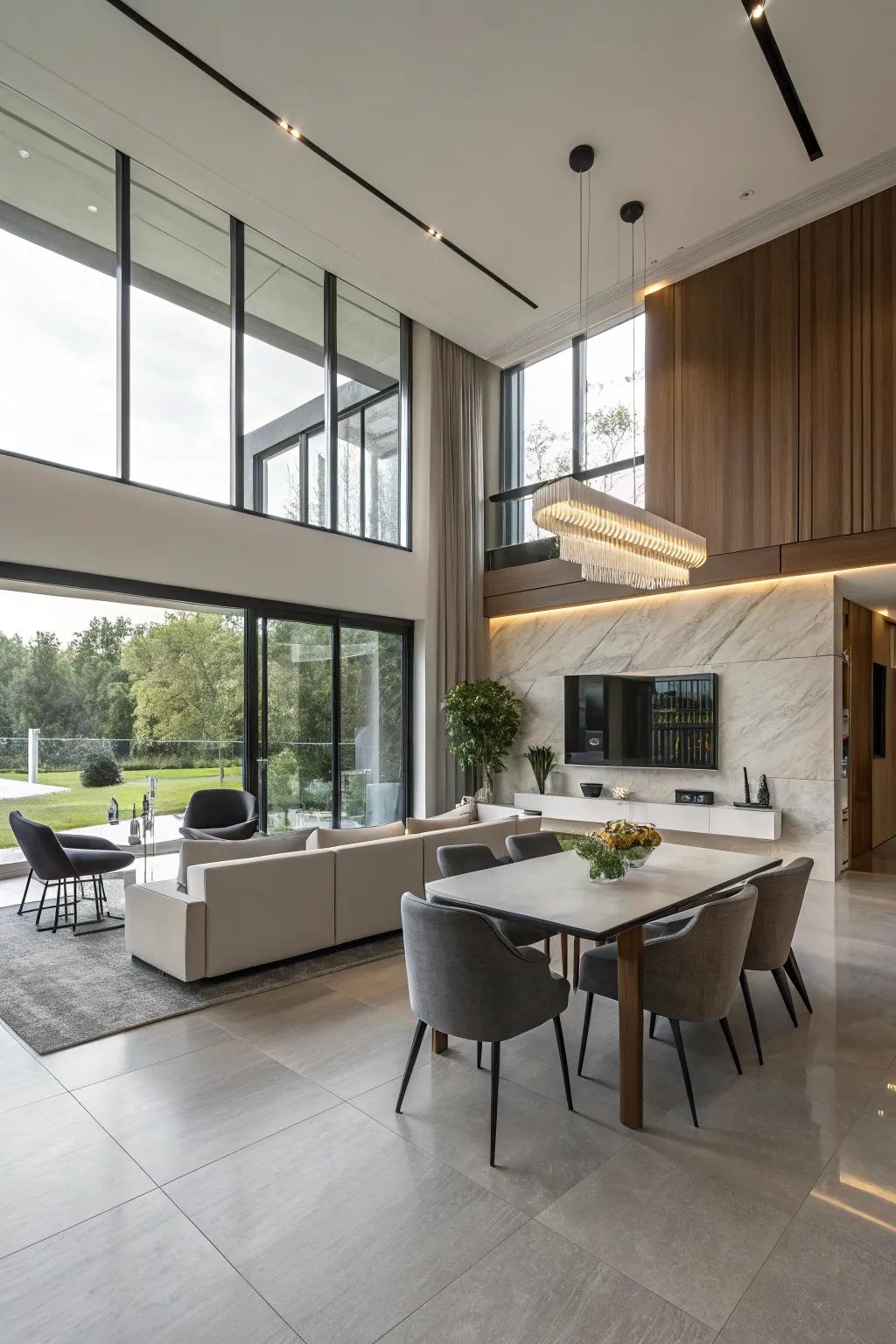
Integrate technology seamlessly into your design. Wall-mounted TVs and discreet sound systems can enhance functionality without disrupting aesthetics.
Explore these options:
10. Less But Better: Minimalism with a Twist
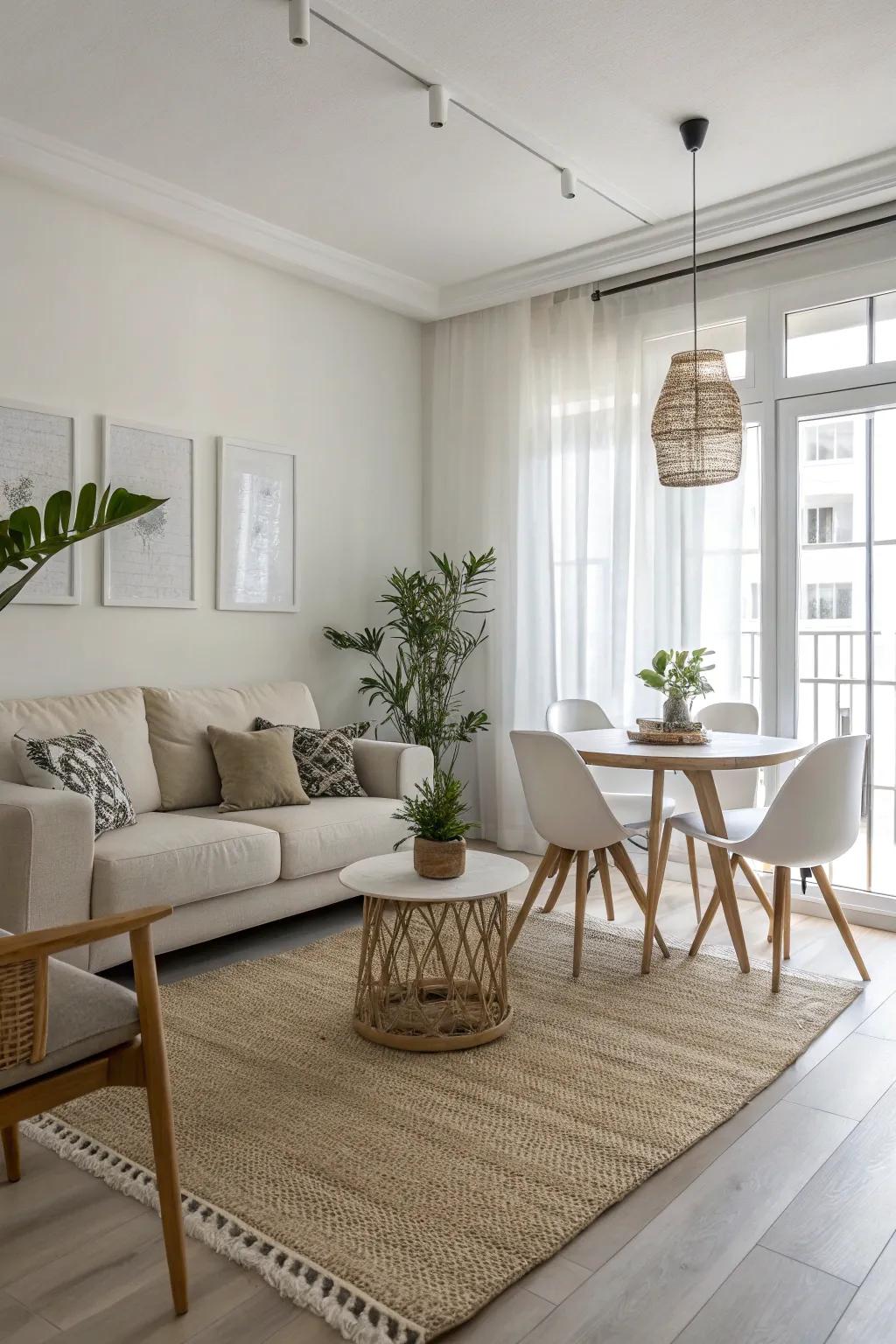
Embracing a minimalist approach in your living-dining combo can be surprisingly freeing.
By focusing on only the essentials—those pieces that truly serve you and your space—you invite a sense of calm and clarity into your everyday life.
I always encourage clients to choose furnishings that marry function and style.
Remember, a well-chosen neutral rug or a sleek pendant light isn’t about less personality, it’s about letting your space breathe and your life take center stage.
Minimalism isn’t about emptiness—it’s about making room for what matters most..
A few things you might like:
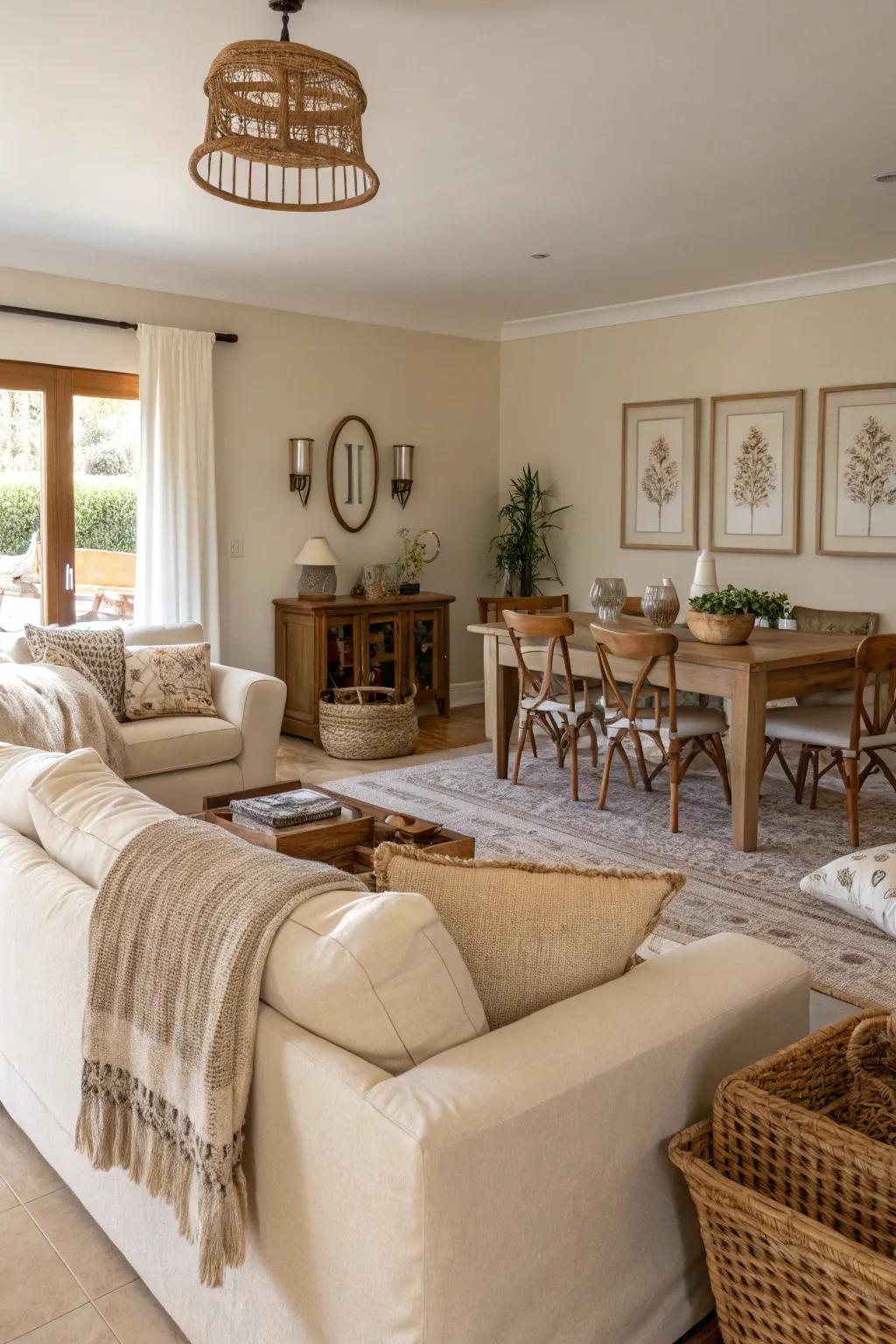
Color isn’t just paint on the wall—it’s the thread that sews your rooms together. In a combo living-dining space, harmony is everything. Think beyond matchy-matchy; the goal is a conversation, not an echo.
When I work with color, I imagine how the sun moves through a room, how evening lamps warm up the walls, or how laughter seems brighter near soft, neutral tones. Ever noticed how a subtle beige can ground a lively patterned rug, or how accents of muted blue in dining chairs can dance across a living room throw pillow?
Here’s how I build a seamless palette:
- Start with a base of neutrals—beige, gray, or off-white always work wonders.
- Weave in one or two accent colors that pop in different forms (cushions, art, ceramics).
- Vary your tones, but stay within the same family for an effortless, curated look.
Remember: every shade you choose is a gentle invitation to relax, gather, and connect.
Your unique color story has the power to make both living and dining shine—separately and together.
Possibly handy products:
12. Could Built-in Storage Change Everything?
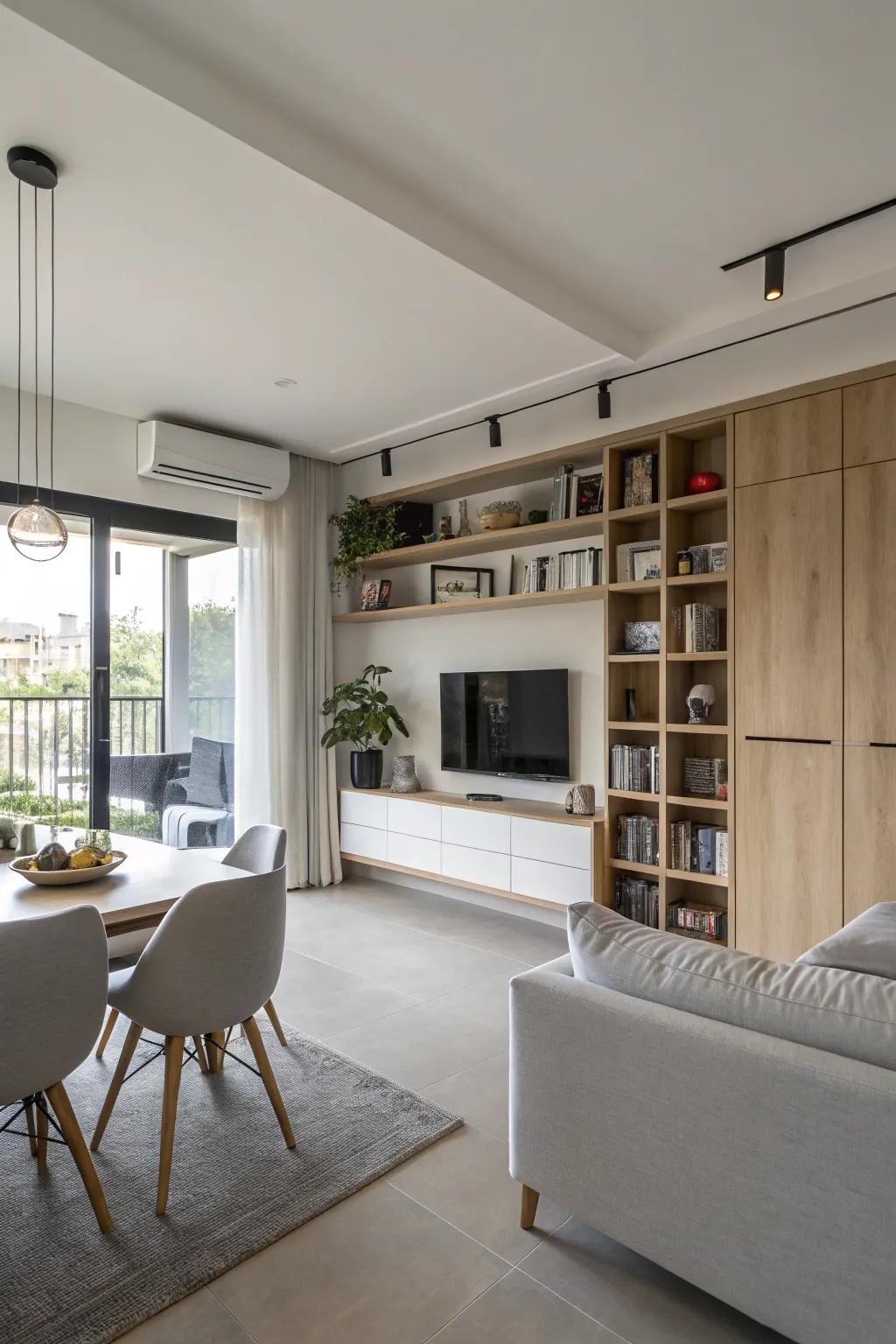
A living room and dining room combo can be a true dance of form and function—when every inch counts, how you manage storage is key.
Built-in storage isn’t just practical, it’s a secret ingredient for a polished, seamless look. I always encourage clients to think beyond stand-alone units. When storage blends into your architecture, your combo space feels both organized and open. Tall built-ins around doorways, window seat benches, or nooks under stairs turn dead zones into treasure troves. And don’t forget—concealed storage keeps your eye focused on beautiful details, not on cluttered table tops!
Here are a few inventive built-in ideas you might not have considered:
- Window bench with hidden drawers below for seasonal linens or board games.
- Narrow pull-out pantry tucked beside a dining area for barware or serving pieces.
- Low, wall-spanning cabinetry under your TV for electronics (and extra dinner plates!).
- Recessed shelving between support columns, perfect for displaying favorite ceramics or books.
Hidden storage brings a sense of calm, even on the busiest days.
One of my most memorable projects was with Paul and Hannah, who wanted their open-plan space to host family dinners and movie nights alike. Custom built-ins not only saved them precious real estate, but also gave them a place for everything—from kids’ craft supplies to special-occasion dishware. The result? Their combo room feels like a true sanctuary, always tidy and entirely welcoming.
Useful items to consider:
13. How Can You Bring the Outside In?
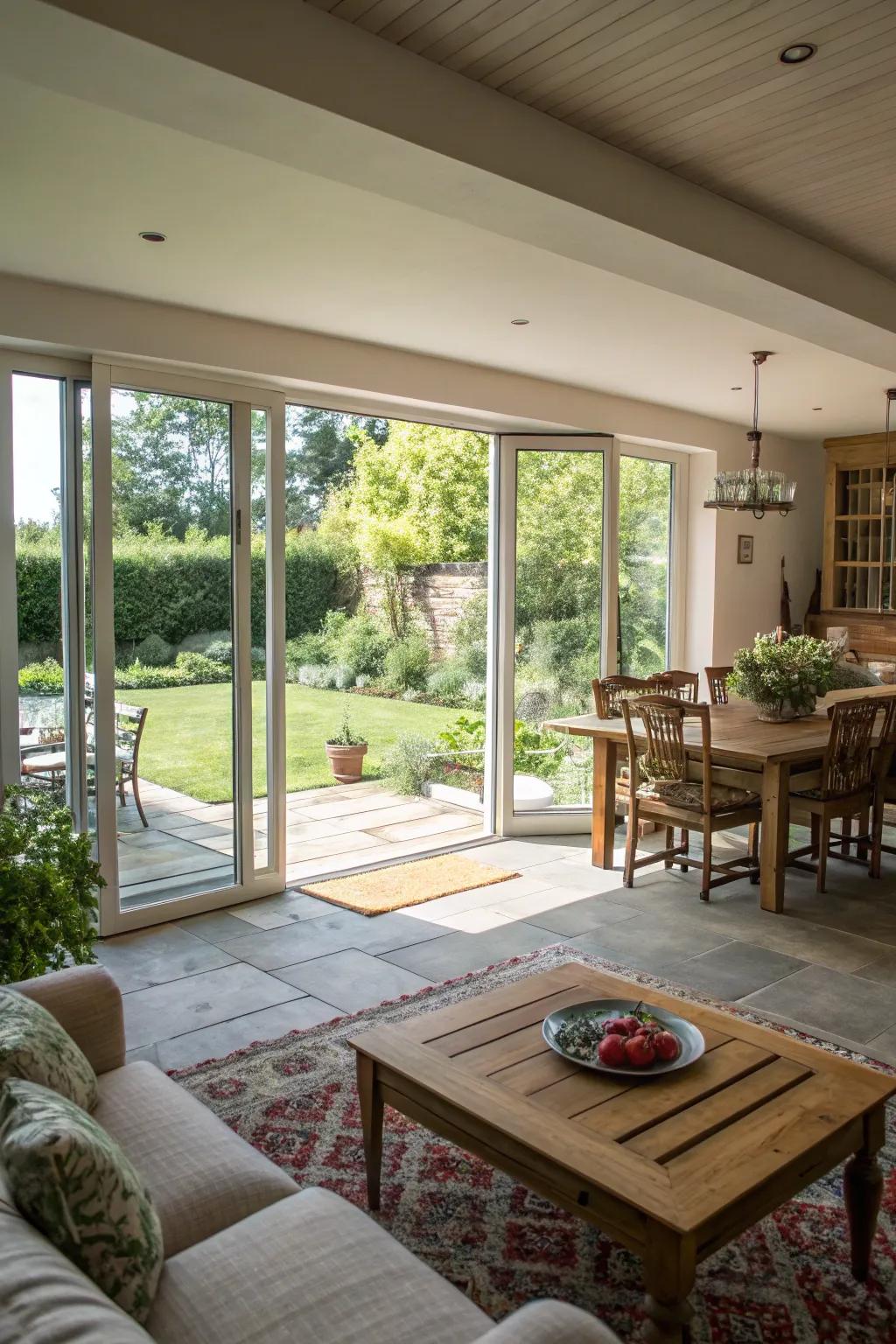
Have you ever wished your living space could breathe in a little more fresh air? Creating a seamless indoor-outdoor connection is more than a design choice—it’s a doorway to relaxation, inspiration, and a touch of nature’s magic. This approach, sometimes called biophilic design, is all about letting the outside world shape your indoor experience, using architectural features and thoughtful styling.
One practical way I helped a client, Emma, achieve this was by expanding her dining room’s glass doors onto a petite patio, making her home feel twice as spacious. If you’re considering this transformation, focus on these elements for a smoother transition:
- Floor-to-ceiling windows or glass doors: Maximizes views and light.
- Consistent flooring between spaces: Unifies the look inside and out.
- Repeating materials, such as wood or stone: Brings harmony to both areas.
Imagine breezes flowing through your living room or sunlight dappling across your breakfast table. The key is to create cues—visual or tactile—that blur boundaries, like using similar color schemes, woven baskets, or an indoor-outdoor rug for a subtle yet powerful link. Even if structural changes aren’t possible, opening up window treatments or strategically placing mirrors can amplify the effect. Are you ready to let your space breathe?
A few helpful options:
14. Symmetry Speaks: Crafting Balance That Feels Effortless
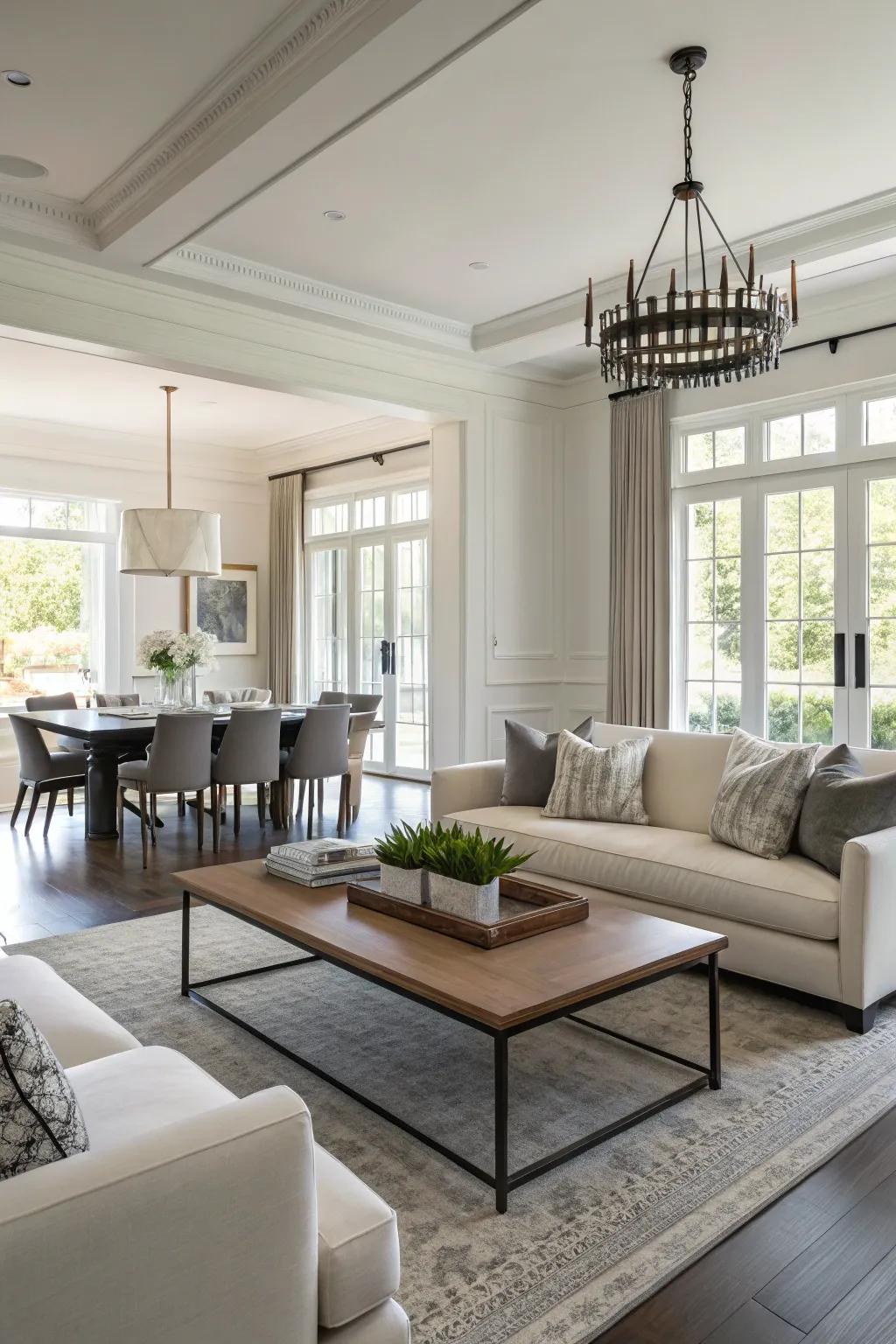
There’s something quietly powerful about symmetry in a living room-dining room combo. When each zone mirrors the other in some way—be it through color, pattern, or furniture placement—you create a grounding sense of harmony that soothes the senses. It’s not just pleasing to the eye; it feels like a gentle exhale at the end of a busy day.
I once worked with the Thompsons, a recently married couple excited to decorate their first shared home. They were drawn to vastly different aesthetics: he loved sleek, ultra-modern lines, while she gravitated toward classic comfort. My solution? Symmetrical arrangements. By anchoring both spaces with matching table lamps, repeating color blocks in the artwork, and placing their sofa and dining table on parallel axes, we achieved a balance that reflected both personalities. The effect wasn’t just visual—it brought a smile to their faces every time they walked in.
To help you infuse a sense of symmetry, consider a few tricks:
- Align key furniture pieces, like sofas and dining tables, along the same visual line for cohesion.
- Use pairs—chairs, lamps, or even art—with matching shapes or hues to quietly echo across zones.
- Stick to complementary color palettes that transition smoothly between living and dining areas.
Sometimes, it’s the smallest details that tip the scales. Have you ever noticed how one lopsided shelf or a rug that’s slightly askew can throw off a whole room’s energy?
Balance isn’t about perfection—it’s about creating an atmosphere where everything feels just right. Let symmetry be your secret ingredient!
Might be a good match:
15. Can Plants Really Divide a Room?
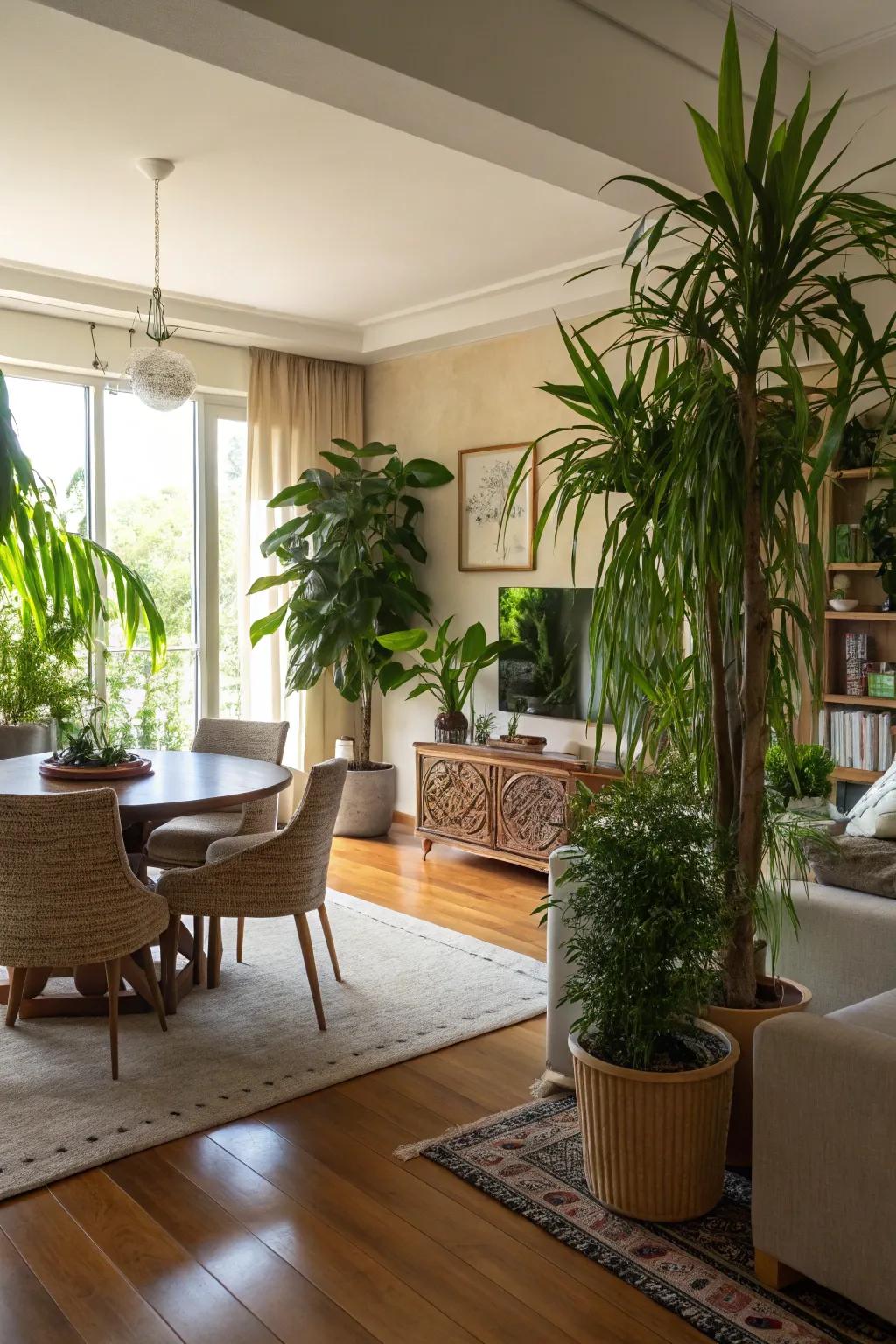
Have you ever felt like your open-plan room just blended a little too much? Adding tall, leafy plants is one of my favorite ways to draw a soft, natural boundary—without making the space feel boxed in. I love how the greenery ushers freshness and movement right inside, blurring the lines between zones in the gentlest way.
Here are two easy ideas to try:
- Place a pair of tall planters back-to-back at the invisible ‘border’ between living and dining zones for a living, breathing divider.
- Select bold, sculptural species (real or faux!) to maximize drama and delight—no green thumb required!
Let nature do the heavy lifting!
A few relevant products:
16. Drawing the Line: How a Sofa Can Shape Your Open-Plan Living
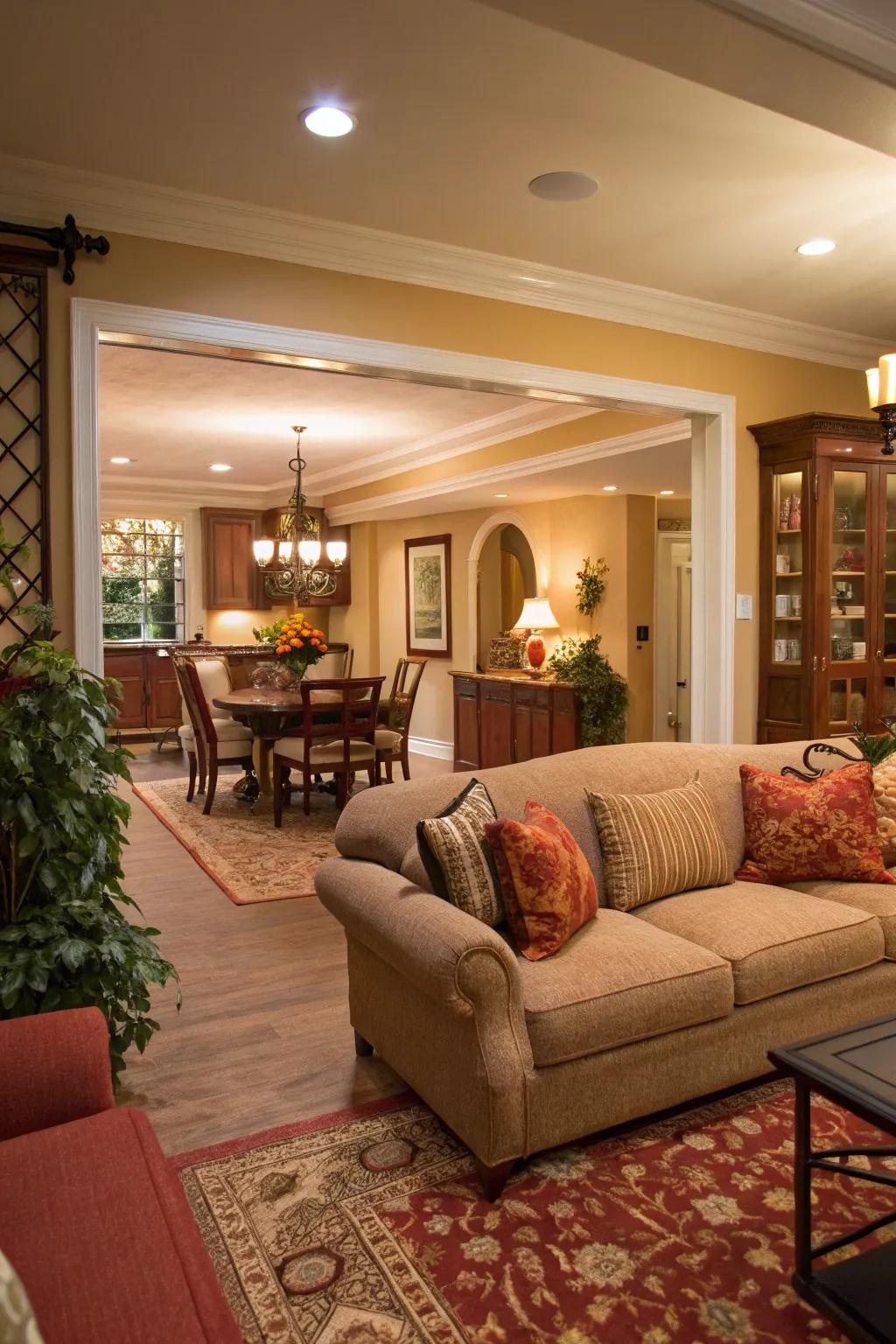
When you’re working with a shared living and dining room, carving out distinct areas can feel like a game of design chess. One of my favorite moves? Using the sofa as a soft boundary—subtle, but oh-so effective.
I once collaborated with a wonderful pair, Emma and Raj, who faced a tricky L-shaped room. Their dining table always felt lost. By positioning a low-profile sofa with its back to the upcoming meal zone and adding a slim console table behind, we gave their dining area its own identity. Suddenly, both spaces felt purposeful. Emma told me later, “It’s like our rooms finally stop arguing. They’re having a conversation now.”
- Float the sofa away from the wall to visually separate areas.
- Place a console table behind for storage and display.
- Layer in different textures (think: a woven basket or a stack of glossy magazines).
- Accent with throw pillows that echo dining room colors for extra harmony.
But here’s a question for you: have you ever felt your open-plan space just needed a little nudge to feel balanced?
I believe a thoughtfully-placed sofa is more than just seating—it’s the anchor that helps the conversation between your rooms flow.
Sometimes, all it takes is a little shift to change the whole energy of your home.
Maybe worth checking out:
17. Round Tables, Big Magic!
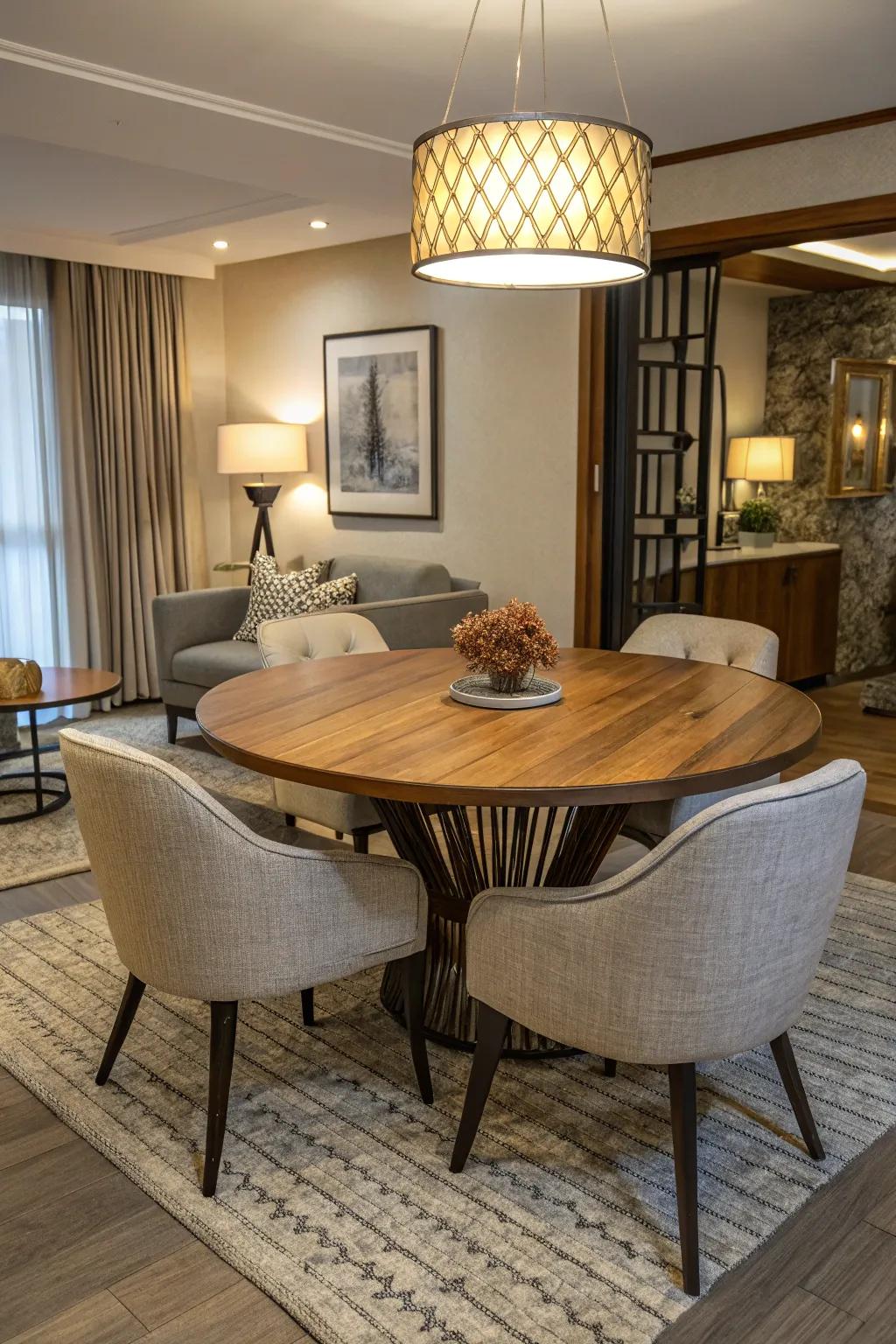
I absolutely adore a round dining table in a living-dining combo. The gentle curves encourage conversation and save precious inches—especially if you’re working with a cozy footprint like my client Sarah. She needed space for her three energetic kids and a spot for guests. One sleek round table in the corner, and suddenly, her room felt twice as inviting. Space-saving style meets pure personality!
A few suggestions:
18. Does Your Room Need a Wow Factor? Create an Accent Wall!
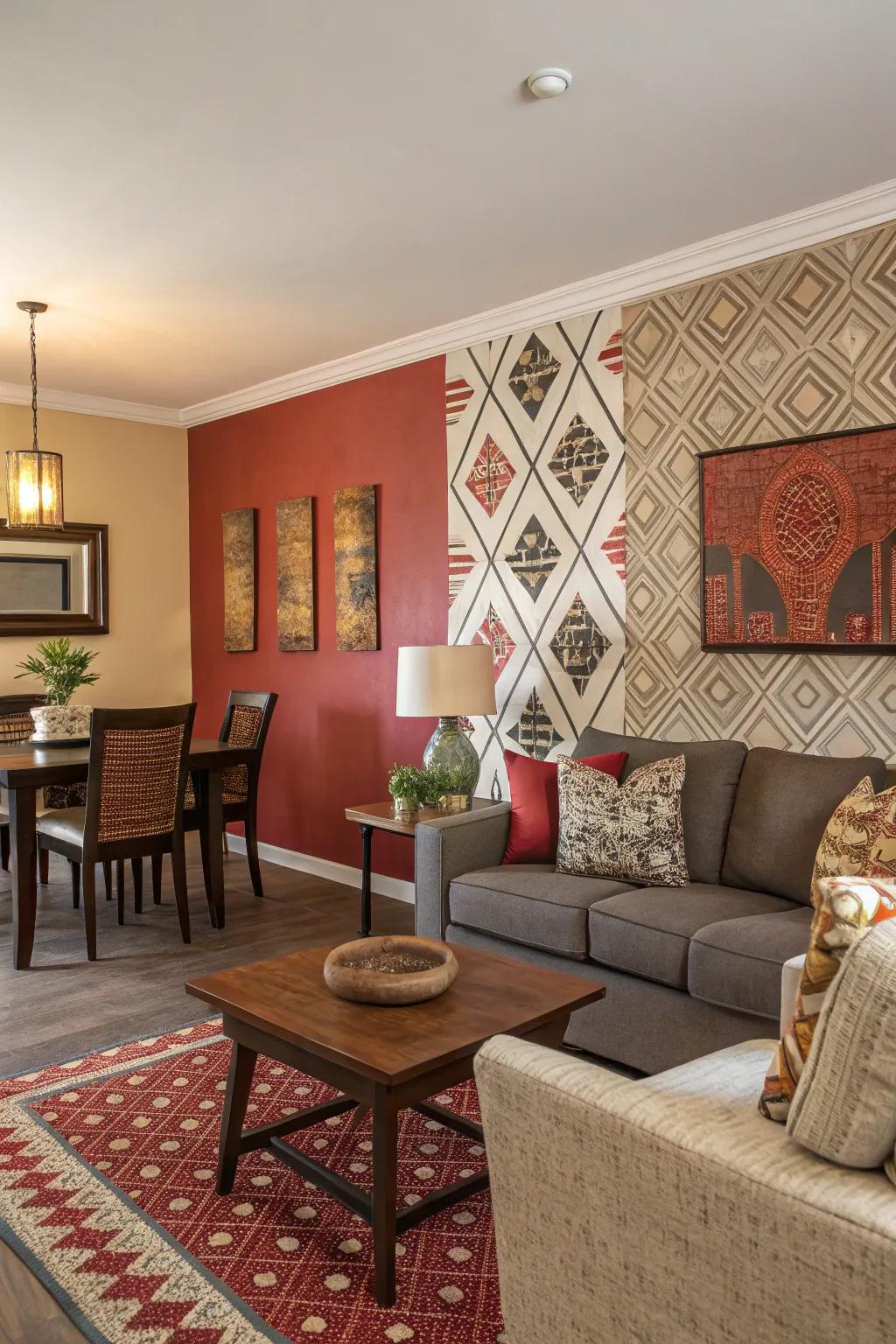
An accent wall is one of my absolute favorite ways to inject personality into a living room-dining room combo—without overpowering your sense of space. Whether it’s a bold splash of color, a dramatic wallpaper, or even a textured finish, this detail instantly becomes a visual anchor. I once worked with the Thompsons, a vibrant family who wanted their entertaining space to feel lively yet unified. We used a deep emerald green on one dining room wall and it completely transformed the vibe—cozy dinners felt more intimate, and lively game nights felt extra festive.
If you’re considering adding an accent wall, start by thinking about which area naturally draws the eye. Then ask yourself: Do I want to create a sense of drama or a subtle whisper of contrast? To spark your creativity, here are a few ideas I often suggest:
- Paint in a bold, saturated hue: Go for a color that makes you smile every time you see it.
- Textured or patterned wallpaper: Add dimension with grasscloth, geometric prints, or faux brick.
- Removable peel-and-stick designs: Perfect if you love to switch things up or are a renter.
Sometimes, the smallest change can make the biggest impact. Even just painting two shades darker than your main wall color can add surprising depth. And don’t forget, lighting plays a starring role in how your accent wall shines. Try spotlighting it with an overhead fixture or art light to draw even more attention to your chosen feature.
Some ideas to consider:
19. Art That Connects: Making Two Spaces Feel Like One Story
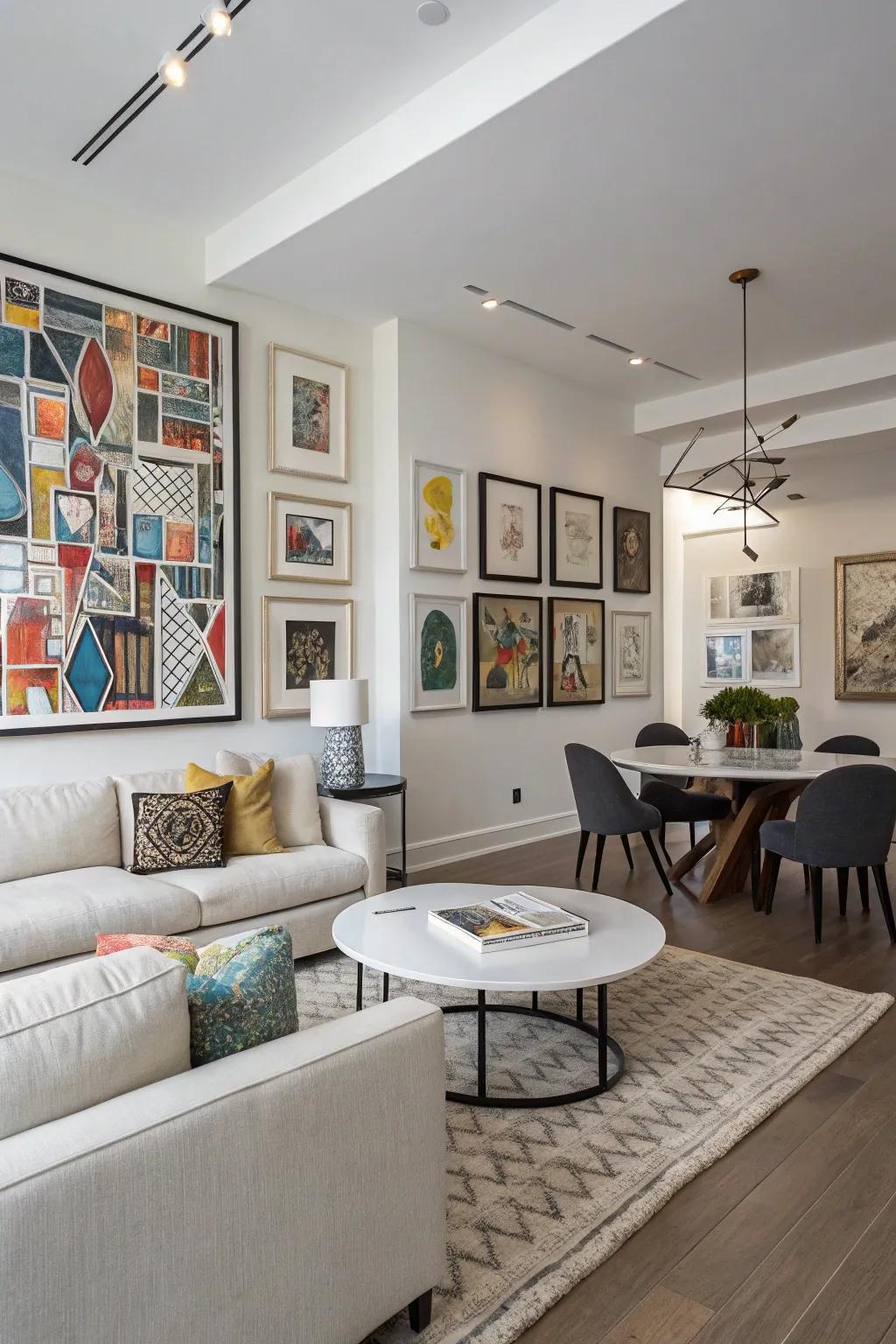
Picture this: you walk into your living-dining combo, and your eyes follow a thread of color, shape, or story from one end of the space to the other. This is what well-chosen art can do. I’m endlessly amazed at how a striking canvas or a thoughtful collection of prints can weave both areas together, making a home feel curated yet deeply personal. Artwork is more than just a finishing touch—it’s a conversation between rooms, a hint of your style that gently nudges zones into harmony.
When choosing art to unite living and dining spaces, keep these strategies in mind:
- Opt for pieces that echo your accent colors or repeat a geometric motif across both rooms.
- Hang coordinating art at identical heights to draw the eye seamlessly through the space.
- Try a gallery wall that bridges the ‘gap’ between zones, including family favorites, abstracts, and a few vintage finds.
- Don’t be afraid to mix mediums—paintings, textiles, and photography blend beautifully for a layered, intentional look.
Art doesn’t just decorate—it narrates.
So the next time you want your living and dining areas to speak the same language, look to your walls. What story will you tell?
The right art bridges more than spaces; it bridges hearts.
Some handy options:
20. Harnessing Height: Why Vertical Elements Matter
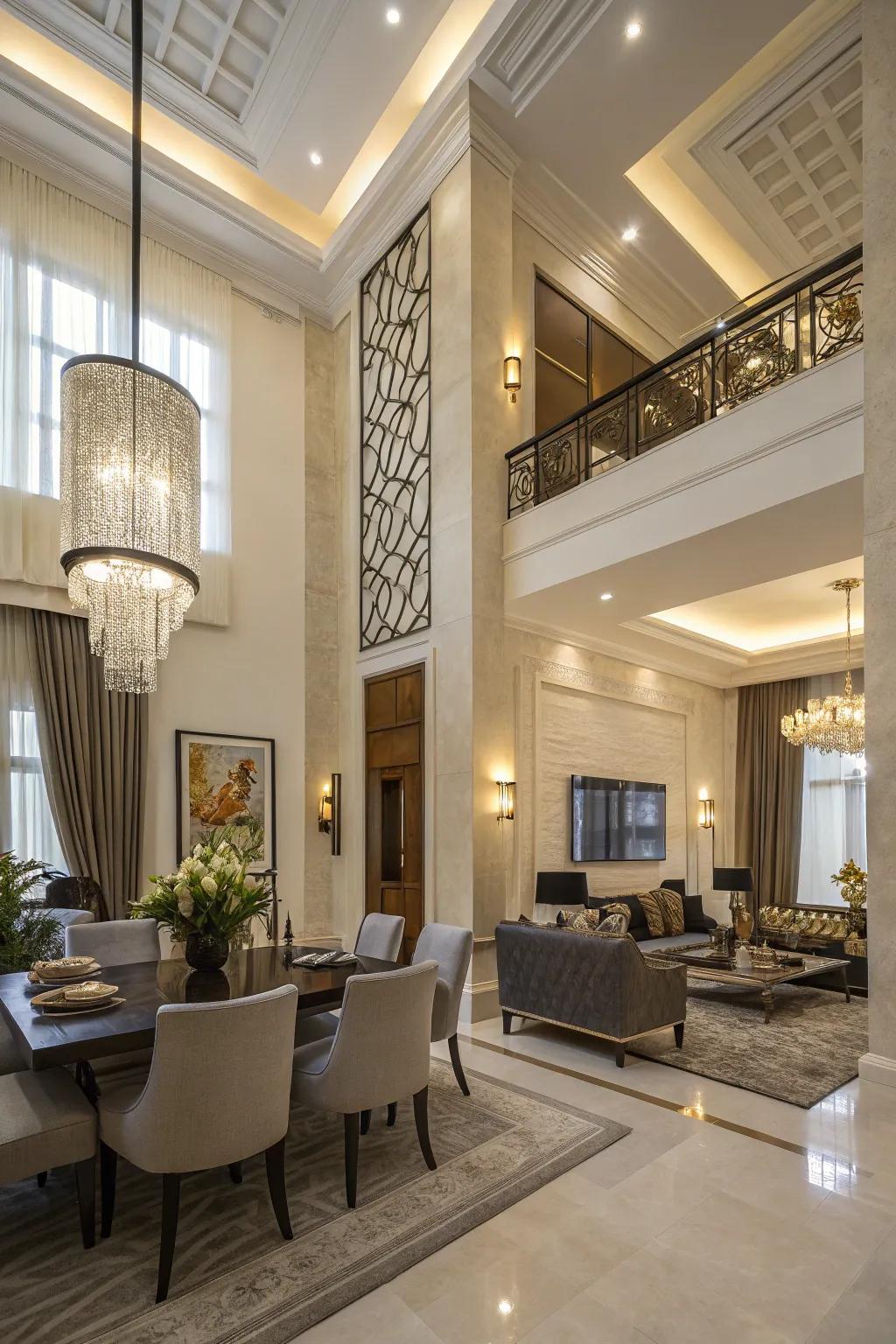
If you’re lucky enough to have high ceilings, vertical elements are your secret weapon. They make every gathering feel grand and give your combo space a sense of effortless height.
- Tall bookcases: Frame a reading nook or the dining table, drawing the eye upward.
- Floor-to-ceiling curtains: Instantly soften and elongate your walls for drama.
- A showstopping chandelier: Carry light and sightlines upward with flair.
What are you highlighting when you look up?
The best part? Vertical lines can unify even the trickiest layouts. Once, I helped the Richardsons maximize their soaring ceilings in a long, narrow room; we hung gentle linen curtains from the very top and installed a slim, sculptural bookshelf next to the fireplace. Suddenly, what once felt cavernous became inviting and purposeful—no more wasted space above or below.
Height is your canvas. Use every inch.
You might give these a try:
21. Layers of Personality: Accessories Speak
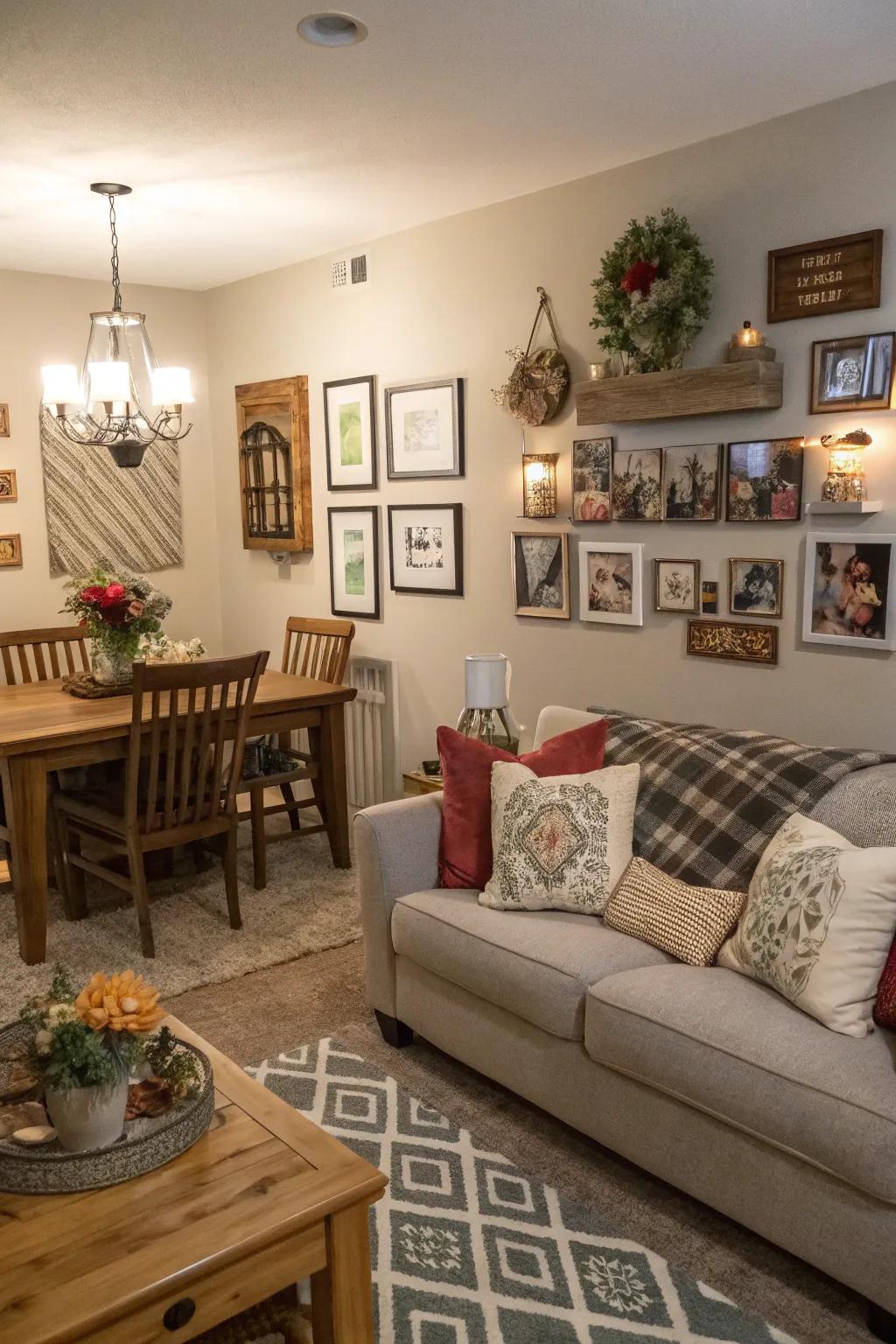
Make your living-dining combo unmistakably you by incorporating thoughtful accessories throughout the space. Don’t underestimate the power of a well-placed object—it can say more about your story than an entire sofa set! Consider mixing and matching these favorites:
- Vases in unique shapes, filled with seasonal greenery or fresh blooms.
- Stacks of hardcover books on coffee and side tables for sophistication.
- Sculptures or figurines that reflect your interests.
- Handmade bowls, baskets, or textiles with a story to tell.
A single, memorable piece can spark conversation and make your guests feel right at home.

